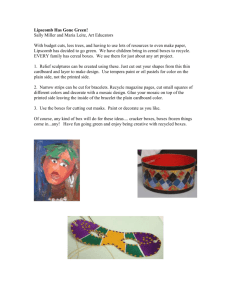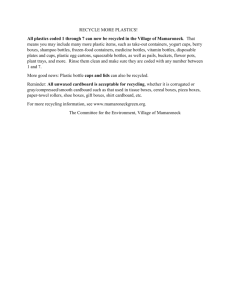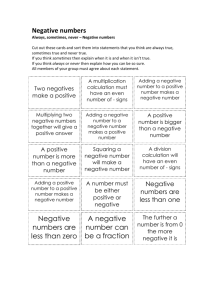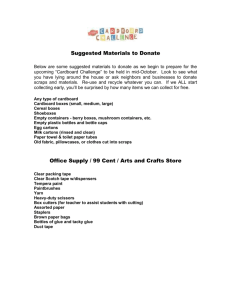New England Trade Adjustment Assistance Center, Inc.
advertisement
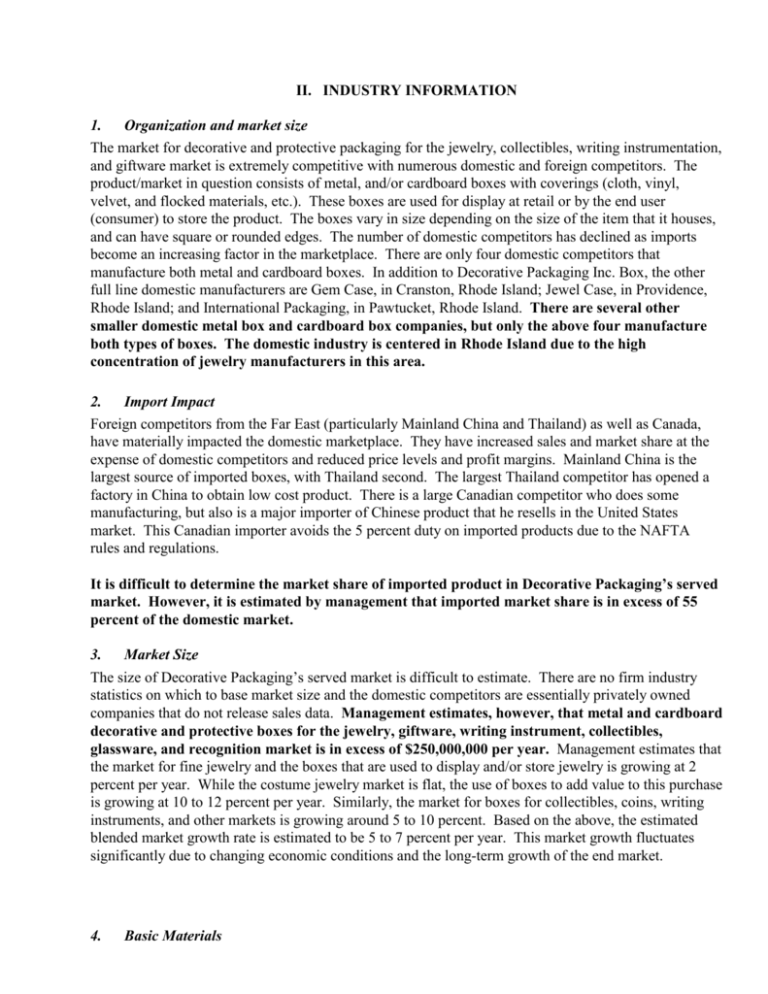
II. INDUSTRY INFORMATION 1. Organization and market size The market for decorative and protective packaging for the jewelry, collectibles, writing instrumentation, and giftware market is extremely competitive with numerous domestic and foreign competitors. The product/market in question consists of metal, and/or cardboard boxes with coverings (cloth, vinyl, velvet, and flocked materials, etc.). These boxes are used for display at retail or by the end user (consumer) to store the product. The boxes vary in size depending on the size of the item that it houses, and can have square or rounded edges. The number of domestic competitors has declined as imports become an increasing factor in the marketplace. There are only four domestic competitors that manufacture both metal and cardboard boxes. In addition to Decorative Packaging Inc. Box, the other full line domestic manufacturers are Gem Case, in Cranston, Rhode Island; Jewel Case, in Providence, Rhode Island; and International Packaging, in Pawtucket, Rhode Island. There are several other smaller domestic metal box and cardboard box companies, but only the above four manufacture both types of boxes. The domestic industry is centered in Rhode Island due to the high concentration of jewelry manufacturers in this area. 2. Import Impact Foreign competitors from the Far East (particularly Mainland China and Thailand) as well as Canada, have materially impacted the domestic marketplace. They have increased sales and market share at the expense of domestic competitors and reduced price levels and profit margins. Mainland China is the largest source of imported boxes, with Thailand second. The largest Thailand competitor has opened a factory in China to obtain low cost product. There is a large Canadian competitor who does some manufacturing, but also is a major importer of Chinese product that he resells in the United States market. This Canadian importer avoids the 5 percent duty on imported products due to the NAFTA rules and regulations. It is difficult to determine the market share of imported product in Decorative Packaging’s served market. However, it is estimated by management that imported market share is in excess of 55 percent of the domestic market. 3. Market Size The size of Decorative Packaging’s served market is difficult to estimate. There are no firm industry statistics on which to base market size and the domestic competitors are essentially privately owned companies that do not release sales data. Management estimates, however, that metal and cardboard decorative and protective boxes for the jewelry, giftware, writing instrument, collectibles, glassware, and recognition market is in excess of $250,000,000 per year. Management estimates that the market for fine jewelry and the boxes that are used to display and/or store jewelry is growing at 2 percent per year. While the costume jewelry market is flat, the use of boxes to add value to this purchase is growing at 10 to 12 percent per year. Similarly, the market for boxes for collectibles, coins, writing instruments, and other markets is growing around 5 to 10 percent. Based on the above, the estimated blended market growth rate is estimated to be 5 to 7 percent per year. This market growth fluctuates significantly due to changing economic conditions and the long-term growth of the end market. 4. Basic Materials Decorative Packaging Inc./Diagnostic Survey and Adjustment Proposal Page 2 The materials used to manufacture a broad range of metal and cardboard boxes are carbon steel, cardboard, and a variety of cloth and fabric materials used to cover the boxes. These materials range from velvet, vinyl, flocked material, and satin for metal boxes, and paper for cardboard boxes. Material costs are the largest single cost incurred by Decorative Packaging, and average approximately 50 percent of sales. Needed materials can be readily purchased from a variety of suppliers. Most of the needed materials are commodities, so it is difficult to obtain a cost advantage via purchasing. One issue is the cost of steel that may rise significantly due to U. S. government anti-dumping measures. 5. Principal Technology The technology to manufacture metal and cardboard boxes is well known and readily available on a worldwide basis. The needed capital equipment is not exceedingly expensive, and the needed labor skills are available throughout the world. Labor costs are the second largest cost incurred in the manufacture of these products. Labor costs of foreign competitors are substantially below domestic labor costs, however. For example, hourly labor costs in China is $.15 versus an average of $9. to $10., plus 25 to 30 percent fringe benefit costs for domestic manufacturers. This is a major advantage since the market is highly price competitive and labor costs are the second highest cost behind material costs. To minimize labor costs, manufacturers invest in capital equipment. While not exceedingly expensive, Decorative Packaging has custom-designed several pieces of capital equipment for its specific applications. In several instances, Decorative Packaging’s metal wrapping equipment is considered state-of-the-art. 6. Principal Types of Competition Many foreign and domestic competitors can manufacture products to the same quality level. Imported products are substantially less in price than domestic products (20 to 25 percent) and are of the same quality. To a great extent, metal and cardboard boxes are purchased as commodities on a price basis by large buyers. Competitors will work with large customers to develop new packages, specific to the needs of the customer. New, successful items will be competitively bid by the customer to reduce his costs. The ability to respond rapidly to the customers’ needs, as well as provide a back-up inventory is essential. While foreign competitors cannot provide backup inventory, large importers perform this service. The key to success is penetrating large end users. The major customers are manufacturers of jewelry, collectibles, writing instruments, etc., and large retailers. Large retailers such as J.C. Penney display jewelry in trays, but when the items are sold at retail, they provide the customer with the box to add value to the purchase and for the customer to store the product. Brand identity and advertising and promotion are not major issues in selling the customer. Price, product quality, which tends to be similar for the major competitors, innovative design, and delivery are the critical issues. 7. Changes in the Marketplace Several large manufacturers who use boxes to store and display their products are losing market share to imports. These imported products are put in boxes overseas and, as a result, these sales are lost to imports. This is true in the jewelry market and in the writing instrument market. For example, A.T. Cross Pens’ sales are down significantly as imports increase market share. As a result, Decorative Packaging’s sales to A. T. Cross have also declined. These imports come into the domestic marketplace in foreign trade boxes. Foreign-made boxes are 20 to 25 percent below comparable domestic products in price. As a result, large retailers and manufacturers are sourcing foreign products to reduce their costs. Decorative Packaging Inc./Diagnostic Survey and Adjustment Proposal Page 3 Imports have steadily increased their share of the domestic marketplace, reducing domestic jewelry industry employment levels and negatively impacting the sales and profits of domestic manufacturers and their suppliers. With the many foreign currencies declining in value compared to the U. S. dollar, foreign manufacturers that can efficiently manufacture cosmetically attractive products have an opportunity to capture increased market share of the domestic U. S. marketplace. With much of the world’s economies in recession (the Far East) or stagnant (Europe). The U. S. market is targeted for penetration. New product introductions (usually cosmetic changes to existing products) offer manufacturers the opportunity to increase sales volume. Successful new products can be and are rapidly copied by foreign competitors. Retailing continues with a trend towards consolidation. Large jewelry chains are replacing the local jewelry store, and large department stores are putting independent stores out of business. As consolidations continue, large retailers utilize their purchasing strength to obtain price concessions from suppliers. There is also a consolidation at the manufacturing level, not only in jewelry, but also in other market segments that the company competes in. As a result, there are fewer, but larger customers who also utilize their buying power to obtain price concessions. This is especially true since the company’s products tend to be purchased as commodities.

